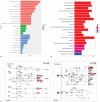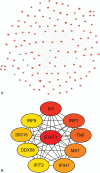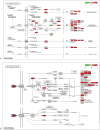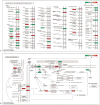Bioinformatics analysis of SARS-CoV-2 infection-associated immune injury and therapeutic prediction for COVID-19
- PMID: 38630100
- PMCID: PMC8447736
- DOI: 10.1097/EC9.0000000000000005
Bioinformatics analysis of SARS-CoV-2 infection-associated immune injury and therapeutic prediction for COVID-19
Abstract
Background: Severe acute respiratory syndrome coronavirus 2 is a highly contagious viral infection, without any available targeted therapies. The high mortality rate of COVID-19 is speculated to be related to immune damage.
Methods: In this study, clinical bioinformatics analysis was conducted on transcriptome data of coronavirus infection.
Results: Bioinformatics analysis revealed that the complex immune injury induced by coronavirus infection provoked dysfunction of numerous immune-related molecules and signaling pathways, including immune cells and toll-like receptor cascades. Production of numerous cytokines through the Th17 signaling pathway led to elevation in plasma levels of cytokines (including IL6, NF-κB, and TNF-α) followed by concurrent inflammatory storm, which mediates the autoimmune response. Several novel medications seemed to display therapeutic effects on immune damage associated with coronavirus infection.
Conclusions: This study provided insights for further large-scale studies on the target therapy on reconciliation of immunological damage associated with COVID-19.
Keywords: Bioinformatics; COVID-19; Coronavirus; Drug prediction; Immune injury.
Copyright © 2021 Shandong University, published by Wolters Kluwer, Inc.
Conflict of interest statement
Sponsorships or competing interests that may be relevant to content are disclosed at the end of this article. Jun Ren is an Associate Editor of Emergency and Critical Care Medicine. The article was subject to the journal's standard procedures, with peer review handled independently of this Associate Editor and their research groups. The authors declare no conflict of interest.
Figures





Similar articles
-
A Network-Based Analysis Reveals the Mechanism Underlying Vitamin D in Suppressing Cytokine Storm and Virus in SARS-CoV-2 Infection.Front Immunol. 2020 Dec 9;11:590459. doi: 10.3389/fimmu.2020.590459. eCollection 2020. Front Immunol. 2020. PMID: 33362771 Free PMC article.
-
Harnessing the immune system to overcome cytokine storm and reduce viral load in COVID-19: a review of the phases of illness and therapeutic agents.Virol J. 2020 Oct 15;17(1):154. doi: 10.1186/s12985-020-01415-w. Virol J. 2020. PMID: 33059711 Free PMC article. Review.
-
Predictions based on inflammatory cytokine profiling of Egyptian COVID-19 with 2 potential therapeutic effects of certain marine-derived compounds.Int Immunopharmacol. 2024 Jan 5;126:111072. doi: 10.1016/j.intimp.2023.111072. Epub 2023 Nov 24. Int Immunopharmacol. 2024. PMID: 38006751
-
Decoding HiPSC-CM's Response to SARS-CoV-2: mapping the molecular landscape of cardiac injury.BMC Genomics. 2024 Mar 12;25(1):271. doi: 10.1186/s12864-024-10194-5. BMC Genomics. 2024. PMID: 38475718 Free PMC article.
-
Dysregulated Interferon Response and Immune Hyperactivation in Severe COVID-19: Targeting STATs as a Novel Therapeutic Strategy.Front Immunol. 2022 May 17;13:888897. doi: 10.3389/fimmu.2022.888897. eCollection 2022. Front Immunol. 2022. PMID: 35663932 Free PMC article. Review.
References
LinkOut - more resources
Full Text Sources
Miscellaneous
